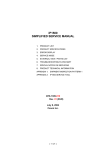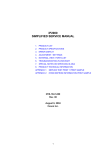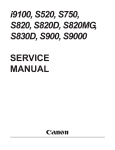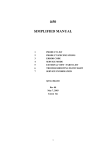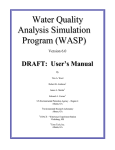Download Canon i320 Service manual
Transcript
i320 SERVICE MANUAL Canon i320 SIMPLIFIED MANUAL 1. PRODUCT LIST 2. PRODUCT SPECIFICATIONS 3. ERROR DISPLAY 4. SERVICE MODE (test print, EEPROM initialization, destination setting) 5. EXTERNAL VIEW / PARTS LIST 6. TROUBLESHOOTING FLOWCHART 7. SERVICE INFROMATION APPENDIX 1: SHIPMENT INSPECTION PATTERN APPENDIX 2: i320 SERVICE TOOL QY8-1383-000 Rev. 00 September 4, 2002 Canon Inc. 2 1. PRODUCT LIST 1-1. Main Units Product name Canon Bubble Jet Printer i320 Canon Bubble Jet Printer Product code Sales Territory 7816A001AA 7816A002AA 7816A003AA 7816A004AA 7816A005AA 7816A006AA 7816A007AA 7816A008AA 7816A009AA 7816A010AA 7816A011AA 7816A012AA 7816A013AA 7816A014AA 7816A015AA US CA LAM LVT LAM HVT AR EUR DE FR ASA HVT AU GB TW HK CN KR 7816A016AA JAPAN Remarks PIXUS 320i 1-2. Options None 1-3. Consumables Product name Product code Sales Territory Canon Ink Tank BCI-24 Black 6881A001AA 6881A002AA 6881A003AA 6881A004AA JPN EUR USA/CAN ASIA/AUST Canon Ink Tank BCI-24 Color 6882A001AA 6882A002AA 6882A003AA 6882A004AA JPN EUR USA/CAN ASIA/AUST Canon Ink Tank BCI-24 Black Twin Pack 6881A008AA 6881A009AA 6881A010AA 6881A011AA JPN EUR USA/CAN ASIA/AUST Canon Ink Tank BCI-24 Color Twin Pack 6882A008AA 6882A009AA 6882A010AA 6882A011AA JPN EUR USA/CAN ASIA/AUST 3 Remarks Common with S200/S200x/S300 /S330 2. PRODUCT SPECIFICATIONS 2-1. Printer Main Unit Specifications Paper feeding method Resolution Printing speed HQ HS CL BK CL BK Printing direction Print width Interface Supported print head No. of pages that can be printed CL BK ASF stacking capacity Paper weight Plain paper High resolution paper Glossy photo paper Professional photo paper / super photo paper / matte photo paper Glossy film Transparency Postcard for ink jet printer / postcard Professional photo postcard / glossy postcard Envelop Professional photo card (PC-101) Glossy photo card T-shirt transfer Mouse pad Borderless printing Detection function Cover open Presence of print head Presence of ink tank Paper out Paper width Waste ink full Ink remaining amount Head alignment Acoustic noise level Fine (glossy paper / high mode) HQ HS ASF 2,400dpi x 1,200dpi (at the highest resolution) 3 ppm (CL through-put pattern) 7 ppm (BK through-put pattern) 6 ppm (CL through-put pattern) 10 ppm (BK through-put pattern) Bi-directional / Uni-directional (automatically switched according to print data and print mode) 203.2mm (8 inches) USB (2.0) *Full Speed only Custom color cartridge only (service part: QY6-0044-000) CL: Approx. 170 pages, BK: Approx. 520 pages (SCID No.5 pattern, default print mode) BK: Approx. 300 pages (1500 character pattern, default print mode) Approx. 320 pages (JEIDA std. J1 pattern, default print mode) Max. 10mm (Approx. 100 pages of 75g/m 2) 64 to 105 g/m 2 10mm or less 10mm (Approx. 80 sheets) or less 10 sheets or less A4/LTR/2L 10 sheets or less L/4x6 20 sheets or less 1 sheet 30 sheets or less 40 sheets or less 20 sheets or less 10 sheets or less L/C/S(4x6) 20 sheets or less 2L/D/W 10 sheets or less 20 sheets or less 1 sheet 1 piece Postcard / L-size paper / 4x6 Available Available Not available Available Not available Available Available (Detected by dot counting. Reset by user operation. Default on.) Available (6 types) Approx. 45 dB Approx. 50 dB Approx. 53 dB (Sound pressure level ISO9296) Temperature Humidity Temperature Humidity 5℃ to 35℃ (41 ゚ F to 95 ゚ F) 10% to 90%RH (no condensation) 0℃ to 40℃ (32゚F to 104゚F) 5% to 95%RH (no condensation) Environmental requirements During operation Non-operation Power supply Input voltage / Frequency Power consumption During printing Stand-by status AC 100∼127V 50/60Hz AC 220∼240V 50/60Hz Approx. 14 W Approx. 1 W (LV) (HV) External dimensions With paper feed/delivery tray extended Approx. 385(W) X 422(D) X 317(H) mm With paper feed/delivery tray set in Approx. 385(W) X 195(D) X 165(H) mm Weight Approx. 2.4kg (excluding the print head and ink tanks) Related standards RFI, Electrical safety FCC, IC, CE, C-Tick, VCCI, Taiwan EMC, Korean MIC, Gost-R, UL, CUL, CB Report, GS, FT, Safety Standards, CCC, Korean EK, SASO, SPRING, TUV (ARG) 4 2-2. Product Life 3 years or 4,000 pages (2,500 pages of color printing and 1,500 pages of black printing), whichever comes first 2-3. Print Head Specifications Structure 4-color integrated type (ink tank separate type) Print head Bk: C/M/Y: Ink drop: Ink colors Bk (new pigment ink) Cl: Y, M, C (high brilliance) Ink tank BCI-24 Bk, BCI-24 Color (Common with S200/S200x/S300/S330) Weight Approx. 60g (excluding ink tanks) Supply method Service part (excluding ink tanks) Part number: QY6-0044-000 Print head life 4,000 pages (Same as the printer main unit, Cl: 2,500 pages, Bk: 1,500 pages of black printing Note: 2 vertical lines, 320 nozzles 2 vertical lines in each color, 128 nozzles Bk 30pl, Col 5pl This print head can only be used in the i320 only, and cannot be used in the old model, S300/S330 series. The print head can be physically installed in the S300/S330, however the print head type is different. Similarly, the S300/S330 print head is not usable in the i320. 5 3. ERROR DIAPLAY Errors are displayed by the LEDs, and warnings are displayed by the status monitor. 3-1. Operator Call Error (Orange LED blinking) LED Display Content Corrective Action Blinking 2 times Paper out Set the paper, and press the RESUME button to feed the paper. Blinking 3 times Paper jam Remove the jammed paper, and press the RESUME button. Blinking 6 times No cartridge installed Install the cartridge, and close the access cover. Blinking 7 times Cartridge installed improperly*1 (Cartridge EEPROM data is abnormal.) Re-install the cartridge properly, or power off and on the printer with the cartridge installed. Blinking 8 times Waste ink full or platen waste ink full warning (Approx. 95% of acceptable amount) Press the RESUME button. 3-2. Service Call Error (Orange and green LEDs cyclical blinking) LED Display Content Corrective Action Blinking 2 times Carriage error Replace the printer as it has failed. Blinking 6 times Internal temperature abnormal error Replace the printer as it has failed. Blinking 7 times Waste ink full or platen waste ink full error Replace the printer as it has failed. Blinking 8 times Abnormal temperature rise Replace the printer as it has failed. Blinking 9 times EEPROM error Replace the printer as it has failed. Blinking 10 times No cartridge installed detection excluding the case of cartridge replacement (during printing) Replace the printer as it has failed. 3-3. Warning (No LED display) Content Remarks Black ink low warning 1 (about half amount) Displayed in the status monitor only*2 Color ink low warning 1 (about half amount) Displayed in the status monitor only*2 Black ink low warning 2 (little amount, “!”) Displayed in the status monitor only*2 Color ink low warning 2 (little amount, “!”) Displayed in the status monitor only*2 Black ink low warning 3 (unknown amount, “?”) Displayed in the status monitor only*2 Color ink low warning 3 (unknown amount, “?”) Displayed in the status monitor only*2 Head temperature rise Displayed when the access cover is opened, the print head temperature is high*3 When the head temperature lowers, the warning is released. Head temperature over-rise protection The carriage stops during printing when the head temperature is excessive. *1: Same as when the non-supported cartridge (print head for S300/S330) is installed. *2: Only when the ink remaining amount detection is ON. (Status is not displayed at OFF.) *3: Printer operation at the warning: When the access cover is opened, the carriage does not move to the cartridge replacement position. 6 4. SERVICE MODE To conduct the following functions, the computer (Windows98/Me), printer driver and service tool (QY9-0058) for the i320 are needed. Function Print head cleaning Procedure Select “Cleaning” from the printer driver utility. Remarks Cleaning time: Approx. 40 sec. < For reference > Head refreshing (deep cleaning) Select “Deep Cleaning” from the printer driver utility. Cleaning time: Approx. 70 sec. Paper feed roller cleaning 1. Remove the paper from the ASF. 2. Select “Feed Roller Cleaning“ from the printer driver utility. 3. Following the instruction from the status monitor, load 3 pages of plain paper in the ASF, and feed them. Test printing 1) Nozzle check pattern printing Select “Nozzle Check“ from the printer driver utility. < For Reference > Head alignment 2) Shipment pattern printing - ROM version - No. of pages fed - Waste ink amount - Destination setting EEPROM reset Destination setting (Japan/Others) Cleaning time: Approx. 2 min. Nozzle check pattern printing 1. Select “Print Head Alignment“ from the printer driver utility. 2. Select the optimal value using the printed head position adjustment pattern. Significant misalignment can be adjusted. Refer to Shipment inspection pattern*1 below. Refer to Shipment inspection pattern sample*3 below. Refer to EEPROM reset / Destination setting*2 below. Refer to EEPROM reset / Destination setting*2 below. *1 Shipment inspection pattern a. Install the print head (QY6-0044-000), and while holding down the POWER button, plug in the AC cable. (The green lamp lights.) b. While holding down the POWER button, press the RESUME button twice, and release it. (Each press of the RESUME button changes the LED color: the LED lights in orange the first time, and in green at the second time.) c. Load A4-sized paper. d. Connect the printer to the computer, select “USB PORT” using the i320 servi ce tool (QY9-0058). (Refer to Appendix 2, i320 Service Tool.) e. Select “TEST PATTERN 1”. The printer starts printing the shipment inspection pattern. *2 EEPROM reset / Destination setting a. Install the print head (QY6-0044-000), and while holding down the POWER button, plug in the AC cable. (The green lamp lights.) b. While holding down the POWER button, press the RESUME button twice, and release it. (Each press of the RESUME button changes the LED color: the LED lights in orange the first time, and in green at the second time.) c. Connect the printer to the computer, select “USB PORT” using the i320 service tool (QY9-0058). (Refer to Appendix 2, i320 Service Tool.) d. <Destination setting> - Other than Japan: Select “1” in “SET DESTINATION”. - Japan: Select “2” in “SET DESTINATION”. <EEPROM reset> EEPROM is reset at the same time when the destination is set. *3 Shipment inspection pattern sample EEPROM setting can be confirmed from the shipment inspection pattern printout. ROM Version Destination setting Other than JPN: 01 JPN: 02 Unused: 03 Waste ink amount (%) No of pages fed: Page: Total No. of pages fed PL: Plain paper HR: High resolution paper GP: Glossy paper CA: Postcard i320 P=V X.XX Destination XX D=XXXXX.X Page=XXXX PL=XXXX , HR=XXXX , GP=XXXX , CA=XXXX SettingTime= XXXX / XX / XX XX:XX YY YY YY YY USB= (YYYYYY) Installation time 7 5. EXTERNAL VIEW / PARTS LIST Parts List Key Part Number Rank Q'ty Description Remark A 0009U22001 1 WHOLE UNIT, W/O POWER SUPPLY UNIT i320 B QH3-3561-000 1 AC ADAPTER: 100/120V 50/60HZ LV (USA,CANADA,JAPAN) QH3-3563-000 1 AC ADAPTER: 220/240V 50/60HZ HV (EUR) QH3-3565-000 1 AC ADAPTER: 220/240V 50/60HZ, CHN/ASIA/AUS HV (CHN/ASIA/AUS) QH3-3567-000 1 AC ADAPTER: 100/120V 50/60HZ, TWN LV (TWN) QH3-3568-000 QY6-0044-000 AC ADAPTER: 220/240V 50/60HZ, KRN PRINT HEAD HV (KRN) K 1 1 XB4-7300-607 N 4 SCREW, PAN HEAD SELF-TAPPING, M3X6 FOR AC ADAPTER & UPPER COVER UNIT C N Power cords are as listed below. WT3-5122-000 E 1 CORD, POWER 100V-120V (J) WT3-5131-000 E 1 CORD, POWER 100V-120V WT3-5132-000 E 1 CORD, POWER 220V-240V WT3-5133-000 E 1 CORD, POWER 220V-240V (AUS) WT3-5135-000 E 1 CORD, POWER 250V (CHN) WT3-5137-000 E 1 CORD, POWER 220V-240V (UK, HK) WT3-5158-000 E 1 CORD, POWER 120V (LAM-LV) WT3-5165-000 E 1 CORD, POWER 220V-240V (AR) 8 6. TROUBLESHOOTING FLOWCHART 6-1. Printer Main Unit Troubleshooting Flowchart (how to printer operation confirmation when refurbishing) Power ON Error displayed? No Yes Open access cover, and install head Error displayed? No Yes Connect to computer Shipment inspection pattern printing Correct? < Shipment inspection pattern check items of > (Refer to the attached print sample.) *Refer to 4. SERVICE MODE regarding printing method. 1. Ink non-ejection: 2. Top margin: 3. Line: 4. Gray area: No Yes Yes Outside of paper Not connected White lines / uneven density Replace head and print shipment inspection pattern Correct? No Yes Waste ink counter less than 7%? No Yes Normal Defective < Note for normal printer refurbishment > At the final step of refurbishment, be sure to reset the EEPROM in accordance with 4. SERVICE MODE, the EEPROM reset procedure. Remove the print head, unplug the power cord immediately, and do not print afterwards. 9 NG NG NG NG 6-2. Print Head Troubleshooting Flowchart (print head operation confirmation) Connect to computer *Refer to 4. SERVICE MODE regarding printing method. Nozzle check pattern printing Correct? Yes No Head cleaning *Refer to 4. SERVICE MODE regarding printing method. Nozzle check pattern printing Correct? Yes No Head refreshing *Refer to 4. SERVICE MODE regarding printing method. Nozzle check pattern printing Correct? Yes No Head refreshing Nozzle check pattern printing Correct? Yes No Replace ink tanks Nozzle check pattern printing Correct? Yes No Normal Defective 10 7. SERVICE INFORMATION 7-1. Whole Unit Replacement When the unit is exchanged as a Whole Unit (WHOLE UNIT, W/O POWER SUPPLY UNIT: 0009U22001 <i320>, take the following procedures: 1. 2. 3. 4. Remove the AC adapter from the printer returned from the user. Install the removed AC adapter in the whole unit. Perform destination setting. (Refer to “4. SERVICE MODE” for details.) Power off the whole unit, and confirm that the printer ready for shipment (with the paper lifting plate of the ASF in the upper position). < Composition of WHOLE UNIT, W/O POWER SUPPLY UNIT > Enclosed items: - Printer unit (without I320’s access cover and AC adapter) - Rating plate (for Asia and Oceania) - Packing material 11 7-2. Product Technical Information 1) FAQ (Problems specific to the i320, and corrective actions) No. Rank* Function Phenomenon 1 A Installatio No cartridge installation n error (orange LED blinks 6 times). Cartridge cannot be installed. Carriage error. 2 A Carriage error, abnormal noise, or paper feeding without printing. Abnormal cartridge EEPROM data error (orange LED blinks 7 times). Condition The packing material used to fix the carriage at unpacking and installation may not have been removed. The packing material used to fix the print head cap at unpacking and installation may not have been removed. 3 A The problem likely occurs when the cartridge lever is slowly (carefully) lowered at print head installation. 4 B 5 B Multi-feeding. When multiple pages of PR101 (A4/LTR) are loaded (in the high temperature and high humidity environment). 6 B Envelope not feeding. When many envelopes are loaded. <Supplement> The problem may occur with the DL envelope. Paper Paper not feeding when The problem may occur when feedability lots of paper/media is multiple pages of PC101L and loaded. (PC101/PR101) PR101 (A4/LTR) are loaded. Cause The user may have failed to remove the packing material at unpacking and installation. Although a caution sheet is packaged together with the printer, the user may not notice it. Note: Even if the packing material remains, no parts are damaged. Corrective action Remove the packing material fixing the carriage. When the cartridge lever is slowly lowered at print head installation, there is a timing mismatch in reading the print head EEPROM value, preventing the EEPROM value from being detected correctly. <Print head recognition mechanism> The print head installation is detected by the contact of terminals in the following procedure: 1. The existence of print head is detected. 2. The print head EEPROM value is checked. When the amount of paper curl is large and multiple pages are loaded, the loaded page limit level in the ASF creates friction at paper feeding. In the high temperature and high humidity environment, the frictional force between the PR101’s front and back sides becomes high, and sheets stick to each other, contributing to multi-feeding. The paper feed roller slips on the paper at paper feeding. Note: Depending on the paper lots. 1. Power off the printer, and re-power it on. 2. Remove the print head, and reinstall it. 12 Remove the packing material fixing the print head cap. 1. Decrease the number of pages loaded in the ASF. 2. Correct the paper curl. Set the paper one by one in the ASF. Possible Call / Claim -LED blinks in orange 6 times (no cartridge installation error) -Cannot install the cartridge -Cannot print -LED blinks in orange and green alternately twice (carriage error) -LED blinks in orange and green alternately twice (carriage error) (As this occurs at printer installation, the user cannot recognize the error.) -Abnormal noise -Cannot print -Paper feeding without printing -LED blinks in orange 7 times (cartridge EEPROM data error) (As this occurs at printer installation, the user cannot recognize the error.) -Cannot print -Paper out error -Paper cannot be fed -Cannot print -Multiple pages of paper are fed -Paper is delivered without printing 1. Decrease the number -Paper out error of envelopes loaded in -Paper cannot be fed the ASF. -Cannot print 2. Straighten out the paper (with a pen). 7 B 8 B 9 B 10 B Image quality Envelop print start When printing is conducted to the position shifts at top top edge of the printable area. edge. <Supplement> <Supplement> Remarkable in the DL envelope. The top margin becomes short. In the worst cases, printing is performed onto the platen. Paper jam. The problem may occur in <Supplement> continuous printing of special The problem occurs just paper (approx. 100 pages or after paper feeding, more). without printing. <Supplement> The problem may occur with the SP101/PR101 series. Smearing on printed The paper curl is substantial. side. <Supplement> -The problem may occur with the DL and COM#10 envelops. -The problem may occur in the address side of KH201 (after continuous borderless printing to the message side), in the high temperature and high humidity environment. Smearing on the When borderless printing is backside of paper, or conducted continuously. smear on address side of postcards. <Supplement> In borderless printing, vertical lines appear around the top edge of backside of printed paper. (transferred from the platen) The paper feed roller slips on the paper at Increase the top margin. -Print position shifts paper feeding. -Smear on the backside Note: Depending on the paper lots. Just after the LF roller starts feeding the 1. Press the RESUME paper, the load at the LF motor increases, button to deliver the causing the out-of-phase of the LF motor. paper. 2. Remove the jammed paper from the paper pick-up or output tray side. The edge of paper rises due to the large 1. Correct the paper curl. amount of curl, causing the print head to 2. Recommend the user rub against the printed surface of paper, to conduct printing in the resulting in smearing. print quality assurance area. (In the i320, the head-to-paper distance cannot be changed.) Note: In borderless printing (to postcard, L-size, 4X6), correct the paper curl. When borderless printing is conducted Clean the ribs on the continuously, ink mist attaches to the ribs platen with cotton on the platen, and is transferred to the swabs/buds. backside of the following paper. 13 -Paper jam error -Paper cannot be fed -Cannot print -Smear on the printed side of paper -Cannot print properly -Paper edge crease <When printing address side of postcards> -Smears on the address side <When printing correct side (message side) of paper> -Smears on the backside 11 B 12 C 13 14 Vertical uneven print density and lines. <Supplement> Uneven print density due to the scan complement control** performed at print data break-up. -When a low specification performance computer is used -When other applications are running -ROM version 1.00 <Supplement> Among special papers with large amount of print pattern data. Note: Comparably remarkable in the specific print pattern (a uniform pattern using single color) Horizontal uneven print -When borderless printing is density and lines at the conducted. trailing edge of paper -When printing is conducted in <Supplement> “Full” to the printable area’s Problem appears within trailing edge. about 30mm from the Note: Comparably remarkable in trailing edge. the specific print pattern (a uniform pattern using single color) Horizontal lines and Special paper / standard mode. uneven print density due <Supplement> to LF roller feeding at Paper of PR series, SP101. small pitch. Note: Comparably remarkable in <Supplement> the specific print pattern (flesh Lines and uneven print tones and a uniform pattern density of 1 to 2mm using a single color) pitches. Horizontal white lines When monochrome printing is and gaps due to LF conducted to the plain paper in roller. the standard mode. <Supplement> Note: Comparably remarkable in the specific print pattern (black halftone graphic pattern). When scan overflow control fails, the scan complement control** is performed at the same position repeatedly, thereby uneven print density and lines appear. (While this phenomenon occurs, the print s peed slows considerably.) <Permanent countermeasure> Rectified in ROM version 1.30 onwards. 1. Close the other applications. 2. Upgrade the ROM from 1.00 to 1.30 onwards. -Lines/uneven print density at the top edge of paper -Cannot print properly When the paper end comes off the pinch Recommend printing in roller, the paper is printed without being the print quality held, preventing the ink drops from being assurance area. ejected in the correct positions, resulting in unevenness. Note: The problem is more severe than that of the S200. -Cannot print to the bottom edge of paper -Lines and uneven print density appear in the trailing edge of paper -Cannot print properly As the print media slightly slips against the feeding amount by the LF roller, printed areas overlap, causing the problem. Change the print quality from standard to high mode. -Lines and uneven print density (on flesh tones and background) -Cannot print properly The print media is slightly overfed against the feeding amount of the LF roller, causing white lines (missing) to appear. <Permanent countermeasure> The printer driver has been upgraded. 1. Change the print -Print head path lines and quality from standard to uneven colors high mode. -Cannot print properly 2. Upgrade the printer driver. Win98/Me: 7.31 onwards Win2000/XP: 1.61 onwards MacOS8.6 and later: 4.11 onwards *Rank A: The phenomenon may occur at a relatively high occurrence ratio. (Caution needed) B: The phenomenon may occur in specific conditions, however the occurrence ratio is expected to be considerably low in the actual usage. C: As the phenomenon is hard to be recognized by general users, it is expected to cause no claims from the users. **Scan complement control Refer to 2) New function, 1. HAPS system below. 14 2) New functions 1. HAPS system The printer adopts a HAPS system for the engine firmware, instead of the previously-used NATIVE system. With the HAPS system, a part of processing functions of the engine firmware has been transferred to the host computer processing, utilizing the computer processing to a maximum, thereby minimizing the engine firmware processing. (Processing is conducted in “OutputModule”, on the printer driver side. Assigned tasks between engine firmware and OutputModule using the HAPS system (as different from the past engine firmware processing functions) Engine firm 1. Control command 2. Print mode 3. Print control 3-1. Usage nozzle switching (HS/HQ) 3-2. Pass switching (HQ) 3-3. Multi-pass (fine) control 3-4. Power monitor (at Bk, 1 pass printing) 4. Delay control 4-1. Smear processing 4-2. Scan delay 4-3. Page delay 5. Borderless printing (incl. counting waste ink amount in absorber on platen) 6. Head alignment 7. Others * Scan overflow control ** Scan complement control O O O O O O O O OutputModule O O O O O O O O O O - * Scan overflow control As the printer cannot store the print data for one scan in the RAM, this function allows printing to start before all print data for one scan is stored in the print buffer. **Scan complement control (printing complement at print data break-up) When the data transmission speed slows as a result of the computer’s data processing capability and load, the print data may break up due to the implementation of overflow scanning. In this case, the print data is complemented at the next scan. 2. Borderless printing The printer supports borderless printing only for postcard, L size paper and 4X6 size paper. Other paper sizes (A4, LTR, etc.) are not supported. < Possible problems with this function > - Smearing on the message side of the postcard, and smearing on the address side in continuous borderless printing -> Clean the ribs on the platen - Smearing on the backside of paper in continuous borderless printing -> Clean the ribs on the platen - Ink mist on the platen -> Clean the ribs on the platen 3. No paper selection lever The printer does not need adjustment using a paper selection lever. (Adjustment of the head-to-paper distance when printing envelopes is not necessary.) < Possible problems with this function > - The head rubs against the paper when the amount of paper curl is large. -> Correct the paper curl. (Less than 3mm) -> In print modes other than borderless printing, conduct printing in the print quality assurance area of the top and bottom edges. (Top margin: 28mm, bottom margin: 26.5mm) 15 4. Quiet mode The printer has a quiet mode function. Compared with the normal mode, Acoustic noise level: Slightly lowers. (HQ, normal: Approx. 50dB, Quiet: Approx. 49dB) Audible overtone level: Sound quality changes, and sound becomes quieter. Print speed: Slows. (Bk printing in HQ/HS mode using an acoustic noise measurement pattern: Approx.1.3 times) 3) Other functions 1. Remaining ink level detection function The printer has a function to detect the remaining ink level. (Default setting: ON) Detection method: Dot counting (Counted for each Bk/Cl ink tank). Cl tank: The remaining ink level is detected by total counted dot values of 3 color ink tanks. Display method: Displayed on the status monitor (at 3 levels shown below for each Bk/Cl ink tank) Level 1: Half level of remaining ink level (Approx. 40% of ink remaining) Level 2: Indication of “!” mark (Approx. 10% of ink remaining) Lever 3: Indication of “?” mark (Remaining ink level is unclear) *Remaining ink detection function displays the status only, and does not cause errors. Accuracy: The margin of error of detection accuracy is +/-10% in normal printing. *The margin of error is likely to be large in the following specific print patterns: When printing continuously using any one of the CMY ink tanks -> As the remaining ink level is calculated by total counted dot values of 3 color ink tanks, if any of the C/M/Y inks is heavily consumed, the margin of error for remaining ink increases. When performing continuous Bk solid printing -> With continuous printing, ink flow from the tank to the ink chamber can be interrupted, after which ink remains unused in the tank. Display procedure: Perform the following operations from the printer driver utility. 1. Set the indication of the remaining ink level in “Low Ink Warning Setting”. 2. Reset the ink counter in “Ink Counter Reset”. *Be sure to reset the ink counter from the printer driver utility after replacing ink tanks. < Possible problems with this function > - Due to user error, the actual remaining ink level does not match the indicated remaining ink level, resulting in “ink out”, etc. User error: Forgetting to reset ink counter / ink counter reset other than when replacing ink tanks. - Due to the specific print pattern, the actual remaining ink level does not match the indicated remaining ink level, resulting in “ink out”. Specific print pattern: Continuous printing using any one of the CMY ink tanks / continuous Bk solid printing, etc. 2. Head refreshing The printer has a head refreshing function. Head refreshing: This is a deep cleaning function in order to resolve print failure due to ink clogging the print head. (The black ink is pigment-based, and clogs easier than the current dye-based ink.) *Perform from the printer driver utility. < Possible problems with this function > - Excessive ink consumption when conducting head refreshing repeatedly. (The amount of ink used is approx. 10 to 15 times the normal manual cleaning amount.) 16 < Reference > Cleaning types, amount of ink used and time required *Bk and Cl ink suction is simultaneously performed. Cleaning type Amount of ink used Time required Manual cleaning Dot count cleaning Timer cleaning (24 hours to 2 weeks) Head replacement Ink tank replacement Cleaning when the head is not capped at printer power on Cleaning on arrival at user Timer cleaning (2 weeks to 3 months) Head refreshing Timer cleaning (3 months or more) Bk: Approx. 0.15g Cl: Approx. 0.15g Approx. 40 sec. Bk: Approx. 0.30g Cl: Approx. 0.30g Approx. 45 sec. Bk: Cl: Bk: Cl: Approx. 0.45g Approx. 0.45g Approx. 1.5g Approx. 2.2g Approx. 60 sec. Approx. 70 sec. 3. Head alignment The printer has a head alignment function (head position adjustment function). (The adjustment is needed at the initial set-up by the user. Head alignment: This is a function to correct the displacements between the nozzle lines of the print head, and incorrect print position at bi-directional printing. The adjustment is conducted using the printed head position adjustment pattern. A: Head alignment between black nozzle lines B: Head alignment between cyan nozzle lines C: Head alignment between magenta nozzle lines D: Head alignment in bi-directional black printing E: Head alignment in bi-directional color printing F: Head alignment between black and color printing *Perform from the printer driver utility. (At initial set-up by the user, instruction on performing the head alignment are displayed in the status monitor.) 17 APPENDIX 1: SHIPMENT INSPECTION PATTERN Check item 1 (Ink non-ejection): Total area of the sample below Check item 2 (Top margin) Print EEPROM information -> Refer to 4. SERVICE MODE for details. Bk nozzle check pattern C nozzle check pattern M nozzle check pattern Check item 3 (Line) Check item 4 (Gray area) Paper size: A4 18 Y nozzle check pattern


















